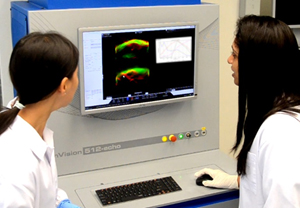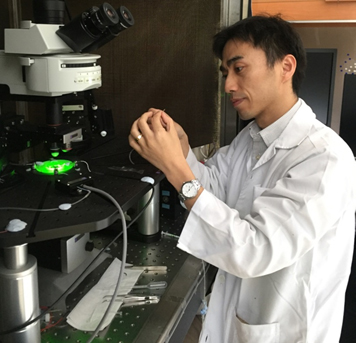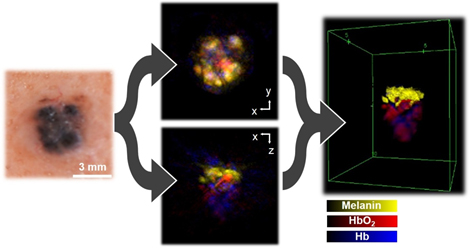A*STAR NEWS
Imaging Today the Medicine of Tomorrow
In close partnership with both industry and clinicians- researchers at the Singapore Bioimaging Consortium are changing the way we see the human body to improve health and well-being.

SBIC has a multidisciplinary team of biologists- physiologists- chemists- physicists- engineers- computer scientists- and clinicians- who investigate pathologies of global importance.
Today- imaging is an indispensable part of the healthcare system. With imaging tools such as magnetic resonance- x-ray and ultrasound- we are able to turn our sights inward and peer into the human body. Such technologies have helped doctors in the treatment- management and diagnosis of diseases- and have saved or improved countless of lives. With an ageing population- and escalating health care costs- there is an urgent need for a deeper understanding of our greatest health problems- to meet the demands for quality health care.
To this end- A*STAR's Singapore Bioimaging Consortium (SBIC) is carrying out a wide range of R&D activities- to investigate major public health issues such as cancer- diabetes and cardiovascular diseases.
"More research is needed to help us understand diseases and develop the technologies of tomorrow"- said Professor Patrick Cozzone- the Executive Director of SBIC. "At the end of the day- we want to achieve translatable clinical outcomes- such as improving the management of patients- and the development of new drugs"- he added.
Housing a comprehensive suite of state-of-the-art bioimaging equipment- SBIC is a national consortium that plays an important role in Singapore's healthcare ecosystem by harnessing imaging expertise towards improving human health. By tapping on a multi-disciplinary team of physicists- chemists- biomedical scientists- and working closely with clinicians- SBIC is supporting national research initiatives to address unmet medical needs. For example- SBIC is developing imaging strategies- and analysing data from Growing Up in Singapore Towards a healthy Outcome (GUSTO) and Asian neTwork for Translational Research and Cardiovascular Trials (ATTRaCT) projects. GUSTO is an intensive birth cohort study which seeks to determine effects of maternal health and lifestyle on growth outcomes of their children- and discover effective prevention and early intervention strategies to optimise health- while ATTRaCT is a multi-agency effort studying the unique characteristics of heart failure in Asians- that will aid in the discovery of new therapeutic targets and repurposing of drugs.

Dr Fu Yu (above) and his team are studying the genetic profile of somatostatin-producing neurons in the tuberal nucleus and their impact on metabolic disregulations in neurodegenerative diseases- which could lead to new therapeutic targets for metabolic diseases.
From bench to bedside
Over 120 scientists- engineers and clinicians working at SBIC have developed strong capabilities in fundamental research while remaining focused on its impact on patients. This approach has already yielded interesting findings- including the potentially game-changing discovery of a new brain region that controls hunger and appetite.
In a study published in Science- Dr Fu Yu and his team at SBIC's Brain Plasticity Group combined advanced neuroimaging with an array of systems neuroscience technologies to show that a structure called the tuberal nucleus regulates food intake and weight gain in mice. These results shed light on a corresponding structure in the human brain—the nucleus tuberalis lateralis—the function of which was previously a mystery.
"In the future- targeting the nucleus tuberalis lateralis to regulate appetite could help address the global obesity epidemic and other metabolic conditions such as diabetes-" Dr Fu said- adding that his team is currently further investigating the role of somatostatin-producing neurons in the tuberal nucleus and how they affect metabolism in neurodegenerative diseases.
"These findings will have far-reaching implications for human health and are a good example of how everything we do at SBIC- from chemistry to pre-clinical studies- considers the impact on patients-" said Professor Cozzone. "Furthermore- the success of this research study demonstrates the importance of multi-disciplinary and collaborative research to achieve major discoveries in modern biomedical sciences."

Seeing with sound
One area where SBIC is especially strong is optical imaging- where light or photons are used to non-invasively obtain detailed images of the body. In particular- scientists like Professor Malini Olivo- who heads SBIC's Laboratory of Bio-optical Imaging- have found a way to take advantage of the photoacoustic effect to ‘see' with sound.
In multispectral optoacoustic tomography (MSOT)- multiple wavelengths of light are used to activate intrinsic light-sensitive biomolecules. Once activated- these biomolecules cause the surrounding tissue to heat up and produce high frequency sound waves that can be detected and processed to produce three dimensional tomography images of the surrounding tissue and specific biomolecules- explained Professor Olivo- who is also Director of Biophotonics at SBIC.
"Using MSOT- we are able to image several centimetres deep into skin and breast tissue with a high resolution that is not possible with other non-invasive methods like positron emission tomography or magnetic resonance imaging-" she continued. "It is a very promising method that gives a greater than 90 percent accuracy as compared to the gold standard of histopathology."
In a clinical trial conducted with the National Skin Centre of Singapore and the Skin Research Institute of Singapore- Professor Olivo and her team showed that MSOT could help surgeons detect the margins of non-melanoma skin cancers in real-time- allowing them to completely remove tumours while minimising excessive tissue removal at the same time. The results of the trial- published in Photoacoustics- and Journal of Investigative Dermatology- were voted the most innovative clinical trial by the World Molecular Imaging Organisations in 2016 and 2017.
SBIC researchers are now investigating how MSOT can be used in other applications such as breast cancer and wound management for diabetic foot ulcers- Professor Olivo said.
It takes three: academia- clinicians and industry
However- a close working relationship with clinicians is not the only ingredient required for success- Professor Cozzone added. Companies- he said- are a crucial part of the equation- too. In the case of the MSOT studies- SBIC worked closely with iThera- a spin-off from the Technical University of Munich- to co-develop and validate innovative technology applications- to advance technology for clinical use.
Reflecting the importance of the combination of advanced research supported by industry- SBIC currently operates five joint labs as well as with industrial partners including Nikon- Bruker and Mediso. It also has a long-term research collaboration with Siemens.
"While it might be impossible to predict the future- we know for sure that artificial intelligence is going to make a profound impact on imaging- which is why we are already working in this area and have attracted interest from major imaging equipment manufacturers-" Professor Cozzone said. Another growth area for imaging research—and one where SBIC already has considerable strengths—is non-invasive- non-irradiative techniques such as optical imaging and magnetic resonance imaging - he added.
"We have built strong foundations over the years; it is now a matter of keeping the right balance between knowledge creation- clinical transfers and industry readiness-" Professor Cozzone concluded.
Was This Article Helpful ?
A*STAR celebrates International Women's Day

From groundbreaking discoveries to cutting-edge research, our researchers are empowering the next generation of female science, technology, engineering and mathematics (STEM) leaders.
Get inspired by our #WomeninSTEM
